OKR methodology has the potential to turn a company into a success. This is why leading companies like Google, Amazon, and Spotify use OKRs to align their teams around a common purpose and drive results.
OKRs are a simple but powerful tool that enables organizations to set ambitious and measurable goals that drive progress, accountability, and innovation. By setting clear objectives and defining key results, teams can stay focused, motivated, and aligned towards achieving their most important goals.
But with so much information and focus on best practices out there, it can be challenging to create an effective OKR strategy that works for your team. In fact, 83% fail to get OKRs right when they launch it for the first time.
That’s where the OKR essential cheat sheet comes in handy.
Checkbox for crafting effective OKRs
For you to craft effective OKRs, there are certain checkboxes that need to be ticked.
Let’s begin with the basics first and see the key elements we need to include in our OKR implementation.
Basics of OKR
OKR is a simple methodology which is centered around setting moonshot goals or objectives and breaking them down into actionable tasks. It is a goal-setting framework used by individuals, teams, and organizations to align their goals and measure progress.
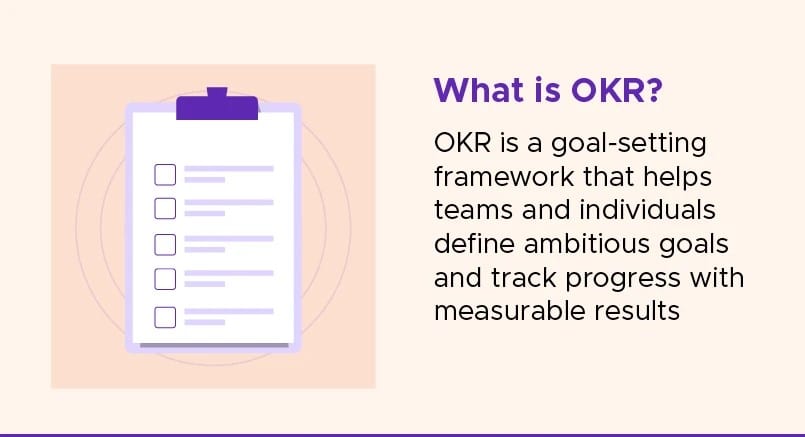
OKR consists of two parts: the Objective, which describes a specific and measurable goal, and the Key Results, which measure progress towards that goal using specific metrics. The Key Results should be measurable, time-bound, and challenging, but still achievable.
The objectives define- What I want to have accomplished
The key results define- How I’m going to get it done
The 3:2 Formula for OKRs
For OKRs to be effective it is important to keep them challenging and yet achievable. This means that each quarter, an individual or team should aim to set no more than three objectives, each with at least two, but no more than five, Key Results.
This approach helps to ensure that goals are specific, measurable, and challenging, while still being achievable within a reasonable timeframe. By regularly reviewing progress against these goals, individuals and teams can stay focused on what matters most and make adjustments as needed to stay on track.
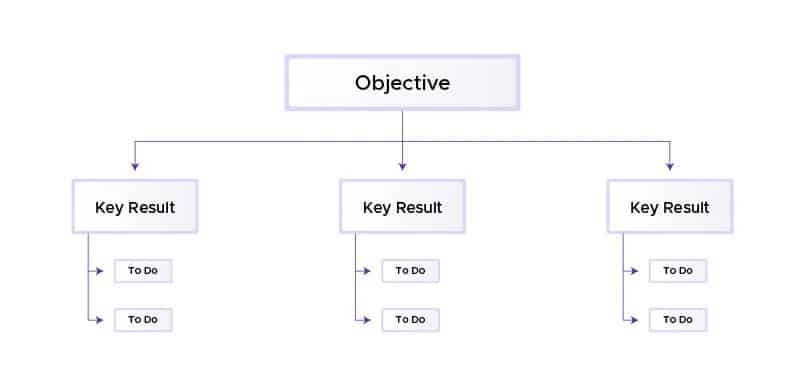
Top Down & Bottom Up Goals, Team & Individual Goals
OKRs can be used for both top-down and bottom-up goal setting. In a top-down approach, organizational leaders set Objectives at a high level, which are then cascaded down to teams and individuals.
In a bottom-up approach, individuals and teams set their own Objectives, which are then reviewed and aligned with the overall organizational goals. This approach allows for greater flexibility and autonomy in goal-setting, while still ensuring alignment with the organization’s overall strategy.
OKRs can also be used to set goals at both the team and individual levels. By aligning individual and team goals with organizational goals, everyone is working towards the same overall objectives. This helps to promote a sense of shared purpose and accountability and can lead to improved performance and outcomes.
KPIs and Initiatives
KPIs (Key Performance Indicators) are quantifiable measurements used to evaluate how well an organization, team, or individual is achieving their strategic goals and objectives. KPIs are typically specific to the organization and may include metrics such as revenue growth, customer retention rate, or employee satisfaction.
Initiatives, on the other hand, are specific actions or projects that an organization or team takes to achieve their strategic goals and objectives. Initiatives are typically designed to improve performance in one or more KPIs.
For example, if an organization’s objective is to increase customer satisfaction, a Key Result might be to achieve a 10% increase in their Net Promoter Score. The KPI used, in this case, would be the Net Promoter Score. Initiatives undertaken to achieve this Key Result might include improving customer service training, implementing a new customer feedback mechanism, or reducing wait times for customer support.
Must Read: How does OKRs differs from KPIs and which one should you choose
A typical OKR vision board should look something like this:
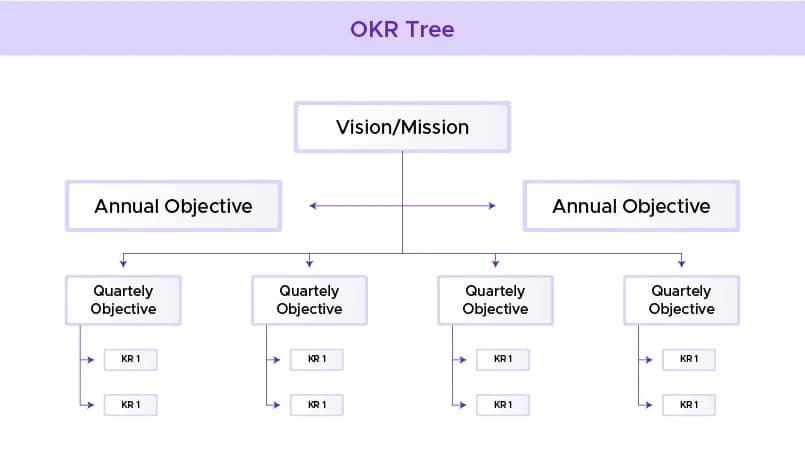
Questions to ask when creating OKRs
When writing OKRs, it is important to ask certain questions. Asking questions is an important step when creating OKRs because it helps to clarify and define the goals. It helps you
- Gain a deeper understanding of the objectives you want to achieve,
- Identify the key results that will help you achieve your objectives
- Ensure alignment and focus
- Ensure we are on the right track
Question to ask when setting Objectives
- What problems and challenges need to be addressed?
- What are the possible solutions?
- What are the roadblocks to implementing these solutions?
- What can be changed to drive better results?
Questions to ask when writing KRs
- Does the measurable outcome solve the problem?
- How to measure change and progress?
- Is success defined and what is the impact made?
- What can be measured to connect initiatives with OKR progress?
Tips for writing specific, measurable, and challenging OKR
1. Be specific
When writing your OKRs, it’s important to be specific and clearly define what you want to achieve. This means being clear on
- What the objective is
- Who is responsible for achieving it and
- What resources will be required.
The more specific your OKRs are, the easier it will be to measure progress and make any necessary adjustments.
2. Use quantifiable metrics
In order to make your OKRs measurable, it’s important to use quantifiable metrics. This means using numbers, percentages, or other concrete measurements to track progress towards your objectives.
By doing so, you can easily determine whether or not you’re on track to achieving your goals.
3. Make the OKRs challenging
Your OKRs should be challenging enough to stretch you and your team, but still realistic enough to be achievable. A good rule of thumb is to set objectives that you believe you have a 50% – 70% chance of achieving. This helps to create a sense of urgency and motivation to work towards your goals. Google strives to achieve 70% of the goals because it makes one feel less high stakes and also leaves scope for pivot that lets your team have breathing space
4. Align them with company goals
Your OKRs should be aligned with the overall goals and strategies of your organization. This ensures that everyone is working towards the same outcomes and that resources are being used effectively. By aligning your OKRs with company goals, you can also increase visibility and support for your initiatives.
5. Focus on the outcomes, not the activities
When writing your OKRs, it’s important to focus on the outcomes that you want to achieve, rather than the activities that you will undertake to get there. This means focusing on the end result and what you want to accomplish, rather than just the steps you will take to get there. By doing so, you can ensure that your objectives are focused on achieving tangible results, rather than just going through the motions.
For example, instead of setting an objective like “Complete 10 training courses by the end of the quarter,” which focuses on the activity of taking courses, you could focus on the outcome you want to achieve and set an objective like “Increase knowledge and skills in X area by 25% by the end of the quarter.”
Examples of well-written OKRs
1. Marketing Department
Objective: Increase website traffic by 30% in the next quarter.
Key Results:
- Increase organic traffic by 20% by the end of the quarter.
- Increase referral traffic by 15% by the end of the quarter.
- Increase social media traffic by 10% by the end of the quarter.
2. Sales Department
Objective: Increase quarterly revenue by $500,000 from existing customers.
Key Results:
- Increase average deal size from $10,000 to $12,000 by the end of the quarter
- Increase cross-selling revenue from $200,000 to $240,000 by the end of the quarter
- Increase upselling revenue from $100,000 to $125,000 by the end of the quarter
3. Operations Department
Objective: Reduce overall production costs by 10% in the next 6 months.
Key Results:
- Reduce labor costs by 5% by the end of the quarter.
- Reduce material costs by 3% by the end of the quarter.
- Reduce overhead costs by 2% by the end of the quarter.
Checking the Alignment of teams
The importance of alignment in achieving company goals lies in the fact that it helps to create a shared sense of purpose and focus. When teams, departments, and employees are aligned, it improves coordination and increases accountability. It maximizes efficiency, enhances agility, and increases employee engagement.
Alignment helps to ensure that everyone is working towards the same objectives, which can lead to better collaboration, improved productivity, cost savings, and ultimately, long-term success for the company.
Strategies for ensuring team alignment
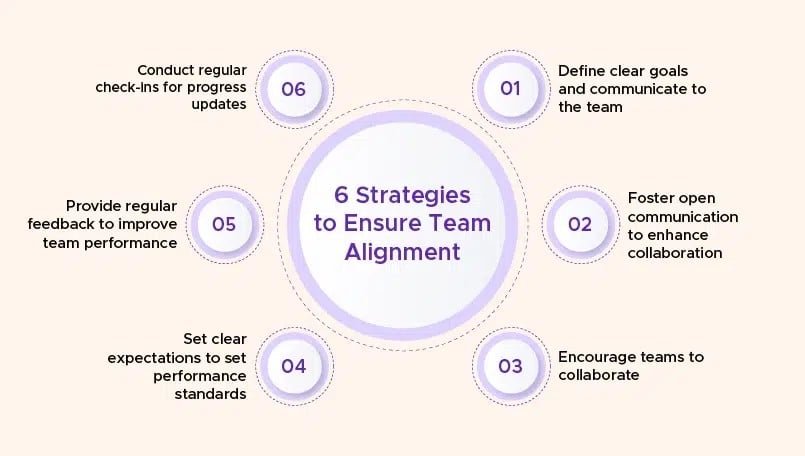
Set clear goals
When goals are clearly defined and communicated to the team, it helps to ensure everyone is on the same page and working towards the same objectives.
Foster open communication
Open communication channels facilitate the sharing of ideas, feedback, and concerns, which helps to create a more collaborative and aligned team.
Encourage collaboration
Encouraging collaboration among team members fosters a sense of teamwork, and it helps to ensure that everyone is well coordinated to work towards the common goals.
Establish clear expectations
Clear expectations help to set a standard for the team’s performance and help to ensure that everyone knows what is expected of them.
Provide regular feedback
Regular feedback helps team members to stay on track and improve their performance. It also helps to ensure that everyone is aware of their progress and any areas that need improvement.
Conduct regular check-ins
Regular check-ins allow for progress updates, feedback, and open communication, which help to ensure that everyone is aligned and working towards the same objectives.
Employee Goal Setting Software
Tools and techniques for measuring alignment
Measuring alignment between individuals or groups can be a challenging task, as it involves assessing how well their beliefs, goals, values, and behaviors match or converge. However, there are several tools and techniques available to measure alignment, including:
1. Progress Tracking Software
A progress tracking software like Peoplebox is an exceptional way to monitor progress towards specific goals and objectives. A good tool provides a visual representation of the completion of tasks, milestones and deadlines. It also ensures alignment and collaboration between team members, particularly in projects involving multiple teams or departments.
A software also helps identify potential roadblocks, facilitate communication, and provide regular updates on progress towards goals, all of which can help improve project outcomes.
2. Regular Check-ins
Regular check-ins, whether they be weekly, bi-weekly or monthly, can help to ensure that everyone is on the same page and working toward the same objectives. During these check-ins, team members can discuss progress, address any concerns or issues, and make any necessary adjustments to their plans. Regular check-ins can also help to identify any miscommunications or misunderstandings that may be preventing alignment.
3. Metrics and KPIs
Metrics and KPIs are specific and measurable data points that are essential for assessing progress towards project goals and objectives. They should be relevant and regularly reviewed to ensure they remain accurate and aligned with project goals. Regular tracking of metrics and KPIs also help identify areas where alignment may be lacking, and necessary adjustments can be made to improve project outcomes.
4. Feedback and Review
Regular feedback and review also help identify areas where alignment may be lacking. By providing constructive feedback and reviewing the work of team members, leaders can ensure that everyone is working toward the same objectives and that work is being completed to a high standard. Additionally, team members should be encouraged to provide feedback to their colleagues and leaders. This helps to keep their morale high, resolve issues they are facing and ensure that everyone is working together effectively and efficiently.
Questions for OKR Weekly Check-In Meetings
Check-in meetings are an effective tool for promoting alignment and collaboration among team members and for ensuring that the project stays on track towards its goals and objectives.
Check-in meetings are held regularly, usually on a weekly basis, to keep track of progress and maintain alignment among team members. Their purpose is to provide a platform for team members to share updates, identify potential issues, and collaborate on solutions to keep the project on track towards its goals and objectives.
These meetings are particularly beneficial in complex projects that involve multiple teams or departments. By holding regular check-in meetings, team members can ensure that everyone is working towards the same goals and objectives, and identify any potential misalignments.
During weekly check-in meetings, it’s important to ask questions that can help to assess progress and identify potential issues. Some questions to ask during weekly check-in meetings are:
- Is the goal on track or not?
- What did we learn from last week?
- What did we do right last week?
- What went wrong? What was not successful?
- What should we do differently next time?
- What are the next plans that might help with Team OKRs?
- Who is doing what? And is it getting done?
- Are there any new directions or updates related to the existing plans?
Scoring or Grading OKRs
Scoring or grading OKRs is a process of assessing the progress and success of objectives and key results based on predefined criteria. The purpose of scoring or grading OKRs is to measure progress towards achieving goals and to ensure that the objectives and key results are aligned with the overall goals of the project or organization.
How to assign scores or grades to OKRs
To assign scores or grades to OKRs, you first need to determine the criteria for evaluation. These criteria could be based on factors such as quality, impact, effort required, or other measurable outcomes.
Once the criteria are established, each objective and key result can be evaluated against those criteria and assigned a score or grade based on the level of achievement.
Grading Scale of OKR (Google Formula 0-1)
The Google formula is a popular grading scale for OKRs that uses a 0-1 scale. This scale assigns a score of 1.0 to an objective or key result that has been fully achieved, and a score of 0.0 to an objective or key result that has not been achieved at all. Intermediate scores between 0 and 1 can be assigned based on the level of completion or success achieved.
Using a tool to measure OKR
Scoring OKRs is crucial but it takes practice to master this skill. This is why a tool is required to help measure and score OKRs efficiently and correctly. A tool provide a more standardized and automated way of assigning scores or grades to OKRs, making it easier to track progress, identify areas for improvement, and ensure that everything is on track with the set timelines.
There are several ways to label your scores based on what tool you use to measure it.
These are some ways you can label you OKR scoring
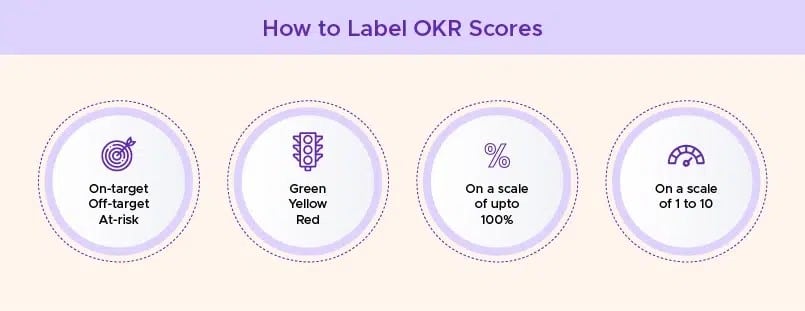
Conclusion
This OKR cheat sheet provides a comprehensive guide to creating and implementing effective OKRs. However, even with the best practices and tips, implementing OKRs can be challenging, especially for larger organizations. That’s why it’s essential to have the right tools and resources to support your OKR implementation process.
One such tool that can help streamline the OKR process is Peoplebox. Peoplebox is an OKR and performance management platform that offers a range of features to support effective goal-setting and tracking. With Peoplebox, teams can create and manage OKRs, track progress in real-time, stay aligned and focused on goals and receive feedback and coaching to ensure continuous improvement.
The lean performance OKR cheat sheet provides a useful reference guide for creating effective OKRs, but to maximize the benefits of OKRs, the right tool is crucial. If you’re looking to streamline your OKR process and improve performance management across your organization, check out Peoplebox.







